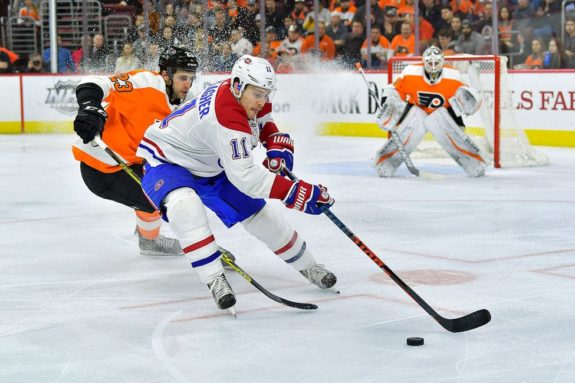A dejected-looking Montreal Canadiens team left the ice after the final buzzer in Edmonton on Monday night after dropping another game, this time by a score of 4-1. The team played solid defensive hockey for 55 or so minutes before being burned by the best player in the world, Connor McDavid. In this instance though, it is hard to say that it was entirely McDavid’s play that led to the loss, as good as he was. The Canadiens simply did not generate much of anything offensively, nor did they make Oilers goalie Mike Smith’s job particularly difficult.
Their only goal was perhaps a lucky redirection off the skate of Eric Staal as he drove the net. I do not mean to disparage this goal as it was actually exactly what the team needs more of. Corey Perry scooped up a loose puck in the offensive zone and made a quick pass to Staal driving the net. These opportunities were few and far between the rest of the game.
This is an unfortunate trend for the team that extends beyond just the game on Monday. Since the loss of Brendan Gallagher, the Canadiens have scored 12 goals in eight games, which is not nearly enough to win games at a consistent rate. He is obviously an important player — there is no denying that — but the team should be capable of much more offensively as a group in his absence.

PHILADELPHIA, PA – FEBRUARY 20: Montreal Canadiens right wing Brendan Gallagher (11) gains control of the puck as Philadelphia Flyers defenseman Brandon Manning (23) chases him. (Photo by Gavin Baker/Icon Sportswire via Getty Images)
In those eight games, however, there is a three-way tie for the most goals between Perry, Tyler Toffoli, and Tomas Tatar, who each have two. There is a caveat here — Perry scored both his goals in one game against the Toronto Maple Leafs on April 7, Toffoli scored both times against the Calgary Flames on April 16, and Tatar’s two goals also came in a single game versus the Maple Leafs April 12. Notably, there are way too many zeros on the board through the rest of the lineup.
It is clear that to solve this drought, the Canadiens are going to have to find ways to score by committee. That is how they were built and it is not likely that any help is on the way.
How, then, can the Canadiens create more offensive opportunities at five-on-five and on the power play? It all comes back to the old cliches.
5-on-5
At 5-on-5, the Canadiens need to find their speed game and find a way to get off the walls in the offensive zone. They have been playing on the perimeter far too often. There is nothing wrong with cycling the puck and wearing down an opponent, but at some point pucks must be funneled to the net. The Canadiens have not put 30 or more shots on net in any of their last six games. In fact, lately they have barely made it over 20.

Some of the more pass-oriented players need to show some confidence and shoot the puck. Here is where the old cliche rings true. You do not have to pick a corner on every shot, but at least give yourself a chance for a rebound or second opportunity. When there have been rebounds and second chances, there has been almost no net drive. This, too, needs to change in a hurry. There is some strategy to timing screens and net drives, but generally this is just where the players need to have the desire and drive to out-work their opponent. If the team wants to play playoff hockey, they should start now by getting tough in front of their opponents’ net.
The Power Play Revisited
This topic always finds a way to re-enter the conversation. After years of struggling, the Canadiens’ power play briefly turned the corner under new assistant coach, Alex Burrows, before losing its effectiveness once again. It is clear that adjustments must be made.
On their last power play against the Oilers Monday night, it appeared they had made changes already. When they managed to set up in the zone, which has been another problem, they essentially ran the power play from down low near the goal line and the back of the net as opposed to the half wall or the point. It did create one chance, but Staal fanned on the shot and the puck exited the zone.
The setup gives the team more potential shooting threats from the side boards by drawing the penalty killers into a more collapsed structure around their net. TSN/NHL Network analyst Mike Johnson broke down the upside of this power play structure nicely on the NHL Network (seen below).
Johnson mentioned how the Sedins loved this setup. There is an obvious Burrows connection there. In any case, this should not be a one-off strategy for the Canadiens. They tried it once very briefly but should pursue it further in the next game. What do they have to lose? It could just help their production.
The small problem with this setup is that the Canadiens do not exactly have a lethal one-timer threat from either wing besides Shea Weber. One option could be to put Jesperi Kotkaniemi or Tatar on the right side and in the one-timer position. On the left side, Toffoli possesses a powerful enough shot that he should be able to beat goalies from the the top of faceoff dot area. We will see if the Canadiens adopt this strategy Wednesday night.
If the Canadiens do not make adjustments soon, it will make for a wild finish to the regular season.